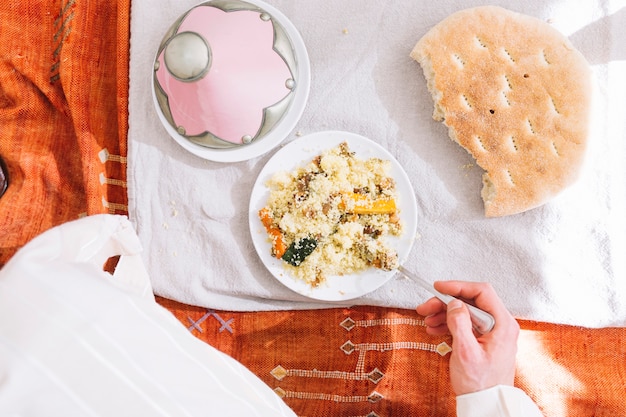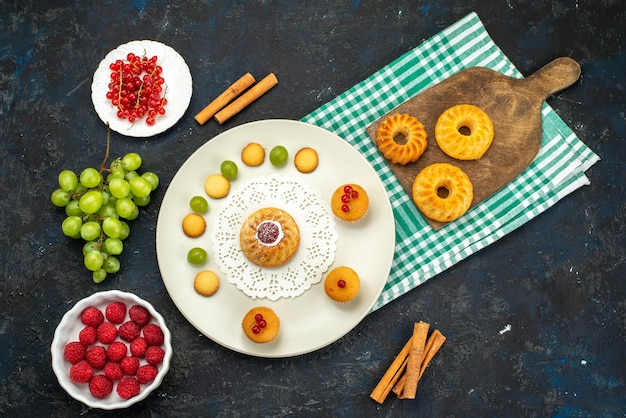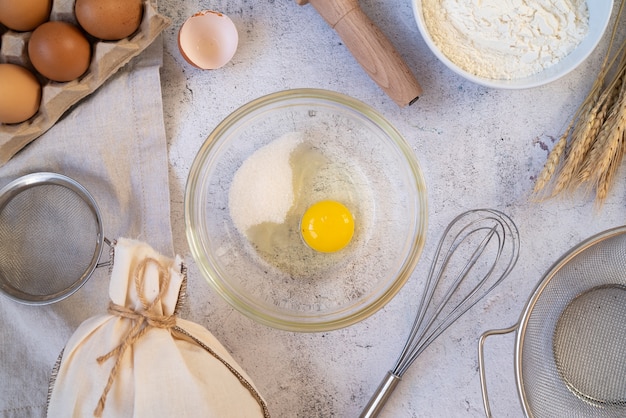Ah, scrambled eggs. A simple dish, yet so often misunderstood. I've spent years wrestling with rubbery omelettes, watery messes, and the occasional burnt offering. But after years of experimentation and countless egg-cellent lessons, I've finally cracked the code to achieving fluffy, melt-in-your-mouth scrambled eggs. And I'm sharing my hard-earned wisdom with you, my fellow egg enthusiasts.
This isn't just a recipe, it's a journey. A quest for the perfect scrambled egg, taking you through every stage of the process, from choosing the right eggs to mastering the art of the gentle fold. So grab your favourite mug, brew a cuppa, and let's embark on this egg-sploration together.
(Part 1) The Eggsploration Begins: Choosing Your Weapon

First things first, you need the right ammunition: the perfect eggs. Don't just grab the first carton you see - this decision is as crucial as choosing the right weapon for a knight. The right egg can make or break your scramble.
The Egg-cellent Egg: Picking the Perfect Protein
We all have our preferences, but when it comes to scrambled eggs, the type of egg you choose can have a significant impact on the final product. Let's explore the options:
Free-Range vs. Barn: This is a debate that's raged for years. Personally, I'm a huge fan of free-range eggs. Those hens get to roam freely, and that freedom seems to translate into a richer flavour and a deeper yellow yolk. But let's be honest, sometimes the budget takes over. Barn eggs can be just as good, especially if you're looking for a more affordable option.
Colour Doesn't Matter: Forget the old wives' tale about brown eggs being superior to white ones. The colour of the shell has nothing to do with flavour or quality. It's all down to the breed of the hen. So don't be swayed by fancy packaging.
Freshness is Key: Always check the 'best before' date on the carton. Fresher eggs mean a better texture and a richer flavour. Trust me, a few days can make a noticeable difference.
(Part 2) The Battleground: Setting Up Your Kitchen

You've got your eggs, now it's time to prepare your battlefield: your kitchen. A well-equipped kitchen is essential for a successful scramble. Think of it like a knight's armoury – you need the right tools for the job.
The Essential Weapons
non-stick pan: Your trusty sidekick in this egg-cellent adventure. A good non-stick pan is a must-have for perfectly smooth, non-stick scrambled eggs. It'll save you from scraping and swearing at burnt bits.
silicone spatula: Forget those metal spatulas that leave your eggs looking like they've been in a fight. A silicone spatula is gentle and will ensure your eggs stay fluffy and intact.
Whisk: This is your trusty companion for mixing, not just for scrambled eggs, but for all your culinary escapades. Choose a sturdy whisk with comfortable handles for effortless egg-whipping.
(Part 3) The Art of the Scramble: The Battle Begins

Now comes the real magic: the moment where your culinary skills are put to the test. This is where your understanding of the egg's temperament becomes critical.
The Egg Whisperer: Mastering the Technique
Start with the Cold: Don't be tempted to use warm eggs straight from the fridge. The coldness will help keep your eggs tender and prevent them from getting rubbery. Let them sit at room temperature for about 30 minutes.
Crack with Confidence: No need to be timid, crack those eggs with a firm hand. You'll be amazed at how much a confident crack can affect the outcome of your scramble.
The Whispering Touch: The key to fluffy scrambled eggs is gentle whisking. Don't over-mix, just give it a few swirls to combine the yolk and white. Aim for a light, airy consistency. Think of it like whispering a secret to your eggs.
The Heat of Battle: The Importance of Temperature
Low and Slow: Forget blasting your pan with high heat. We're going for gentle heat, my friend. Medium-low heat is your best bet, allowing the eggs to cook slowly and evenly, without burning.
The Sign of the Pan: Check your pan. If you see a tiny ripple of heat coming off it, you're in the right temperature zone. It's like a little dance between you and the pan. A dance that leads to egg-stacy.
(Part 4) The Battle for Texture: Adding the Right Ingredients
Now we're getting into the meaty part of the scramble. What's a battle without a little extra flavour and texture? Let's add some deliciousness to our eggs!
The Secret Weapon: Milk or Cream
The Creamy Touch: Adding a splash of milk or cream is like adding a touch of silk to your scrambled eggs. It'll make them richer, creamier, and prevent them from drying out. A bit of milk goes a long way.
Butter is Your Best Friend: A knob of butter will give your scrambled eggs a rich, buttery flavour and a beautiful sheen. Just don't go overboard, we're aiming for a subtle touch, not a greasy mess.
The Spice of Life: Seasoning the Battleground
Salt and Pepper: This is a no-brainer, but even a pinch of salt and pepper can elevate your eggs from bland to brilliant. Don't be afraid to experiment with different types of peppercorns.
Herbs and Spices: Want to add a touch of zest? A sprinkle of dried herbs like chives, parsley, or a pinch of garlic powder can add a beautiful flavour. But remember, a little goes a long way.
(Part 5) The Final Assault: Bringing It All Together
We're getting close now, the final stage of our egg-cellent adventure. It's time to bring all the elements together and orchestrate a perfect scramble.
The Gentle Fold: Mastering the Art of Cookery
Cook in Batches: Don't overcrowd your pan. Cook your eggs in batches, ensuring they have enough space to cook evenly and become gloriously fluffy.
The Fold Technique: Use your silicone spatula to gently fold the eggs, not stir them. Think of it like gently folding a blanket. This will prevent your eggs from becoming rubbery and ensure they stay light and airy.
Don't Overcook: Keep your eyes peeled, because scrambled eggs cook quickly. Once they're set and just slightly moist, they're ready. Overcooked eggs will be dry and rubbery, so remember to pull them off the heat just before you think they're ready.
The Finishing Touches: Elevating Your Scramble
The Cheese Factor: Add a sprinkle of grated cheese at the end of cooking for a cheesy, gooey delight. A few pinches of parmesan or cheddar will take your scrambled eggs to the next level.
Fresh Herbs: Nothing beats the flavour of fresh herbs. A sprinkle of chopped chives, parsley, or a few basil leaves will add a delightful freshness to your scrambled eggs.
(Part 6) The Aftermath: The Joy of the Perfect Bite
After all that hard work, it's time for the reward. The moment you've been waiting for – the first bite of your perfectly fluffy scrambled eggs.
The Moment of Truth: Tasting the Victory
The Test of Texture: The first bite should feel like a gentle cloud melting in your mouth. No rubberiness, no dryness, just pure, fluffy heaven.
The Flavour Symphony: The flavour should be balanced and rich. The buttery notes should mingle with the subtle sweetness of the eggs and the added flavour of herbs or spices.
The Satisfaction of Success: A perfect scrambled egg is more than just a meal. It's a testament to your culinary skills, a moment of pure satisfaction.
(Part 7) The Evolution of the Scramble: Beyond the Basics
Now that you've mastered the fundamentals, it's time to push the boundaries, to explore the endless possibilities of the scrambled egg.
The World of Flavours: Experimenting with Ingredients
Mediterranean Scramble: Add chopped sun-dried tomatoes, feta cheese, and fresh oregano for a taste of the Mediterranean sunshine.
Spicy Scramble: Add a pinch of cayenne pepper, chopped jalapenos, or a dollop of sriracha for a fiery kick.
Cheesy Scramble: Embrace the cheesy goodness by adding a blend of cheddar, mozzarella, and Monterey Jack for a truly indulgent experience.
The Art of Presentation: Transforming Your Scramble
Scrambled Egg Stacks: Elevate your scrambled eggs by stacking them in a neat tower on your plate, garnished with fresh herbs or a sprinkle of paprika.
Scrambled Egg Bowls: Serve your scrambled eggs in a warm, rustic bowl, topped with a poached egg or a dollop of sour cream.
Scrambled Egg Breakfast Burritos: Wrap your scrambled eggs in a warm tortilla, add some sauteed vegetables, cheese, and salsa for a hearty and satisfying breakfast.
(Part 8) The FAQs: Answering Your Egg-cellent Questions
Let's tackle some common questions that might be swirling in your mind about the world of fluffy scrambled eggs.
1. Can I use store-bought egg whites?
Yes, you can, but be careful. Store-bought egg whites can sometimes be a little dry, so add a splash of milk or cream to help them stay moist.
2. How long should I cook my scrambled eggs?
The cooking time will vary depending on the heat and the number of eggs you're cooking. It's best to keep an eye on them and cook them until they are just set and slightly moist.
3. Can I freeze scrambled eggs?
It's not recommended to freeze scrambled eggs, as they can become dry and rubbery when thawed. It's best to cook them fresh each time.
4. What can I add to my scrambled eggs for extra protein?
You can add chopped ham, bacon, sausage, or even diced cooked chicken breast to your scrambled eggs for extra protein.
5. What are some delicious toppings for scrambled eggs?
The possibilities are endless! You can top your scrambled eggs with avocado, salsa, guacamole, chopped tomatoes, crumbled bacon, or even a drizzle of hot sauce.
The Conclusion: A Journey to Egg-stacy
And there you have it, my friends, the ultimate guide to fluffy scrambled eggs. Remember, it's not just about following a recipe, it's about understanding the egg's character and letting it guide you through the process. Experiment, explore, and never stop striving for that perfect, cloud-like bite. Happy scrambling!
Everyone is watching

Prime Rib Roast Cooking Time Chart: Per Pound Guide
Cooking TipsPrime rib roast. Just the name conjures images of lavish dinners, crackling fires, and hearty laughter. It’s ...

How Long to Bake Potatoes in the Oven (Perfect Every Time)
Cooking TipsBaked potatoes are a staple in my kitchen. They're incredibly versatile, delicious, and surprisingly easy to m...

Perfect Rice Every Time: The Ultimate Guide to Cooking Rice
Cooking TipsAs a self-proclaimed foodie, I've always been a bit obsessed with rice. It's the foundation of countless cuisi...

The Ultimate Guide to Cooking Asparagus: Tips, Techniques, and Recipes
Cooking TipsAsparagus. The mere mention of this spring delicacy conjures up images of vibrant green spears, crisp and burs...

Ultimate Guide to Cooking the Perfect Thanksgiving Turkey
Cooking TipsThanksgiving. Just the word conjures up images of overflowing tables laden with delicious food, the scent of r...
